Right Bank Satellites 2018
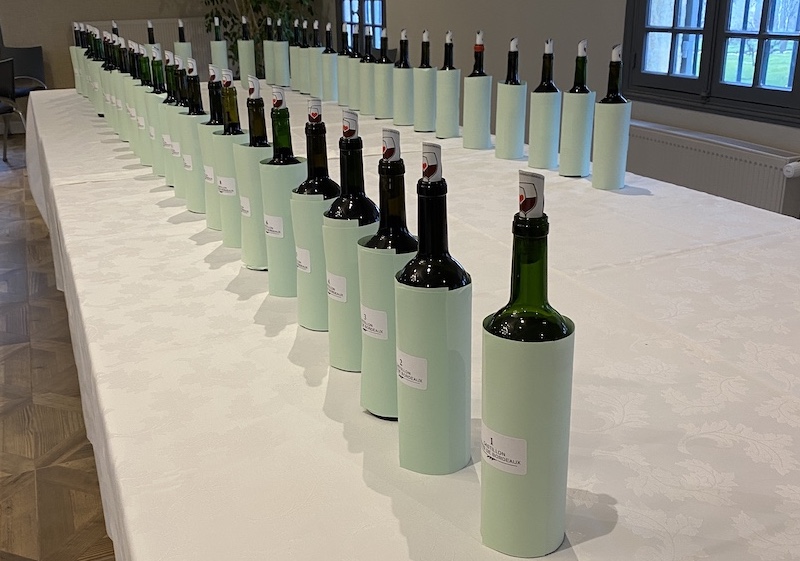
Mostly Castillon: some excellent, affordable wines
By Panos Kakaviatos for wine-chronicles.com
24 January 2021
Many less heralded appellations from the Right Bank with cooler clay and/or limestone soils excelled in 2018. But I did not get to too many of them. We can start with Montagne Saint Emilion and Jean-Claude Berrouet, whose name resonates in the wine world as one of its greats, thanks in large part to his many years crafting Petrus in Pomerol. In Montagne Saint Emilion, owns Château Vieux Château Saint-André, which he had purchased in 1979 as well as Château Samion (Lalande de Pomerol), in 1982. His son Jeff took over in 2002, and I have visited several times, always impressed by the freshness and refinement of both wines, which never fell prey to the exaggerated modern era on the Right Bank. Old Merlot vines, 40 years old in Montagne and 50 years old in Lalande de Pomerol, match with excellent clay soils. Vinifications preserve fruit freshness, and tannins are carefully extracted without excess, before the wine ages twelve months. In 2019, the Berrouets acquired two new estates: Château Bonneau, 6 hectares in Montagne-Saint-Émilion and Château Hyon La Fleur, 2.5 hectares in Saint-Christophe-des-Barde (Saint-Émilion).
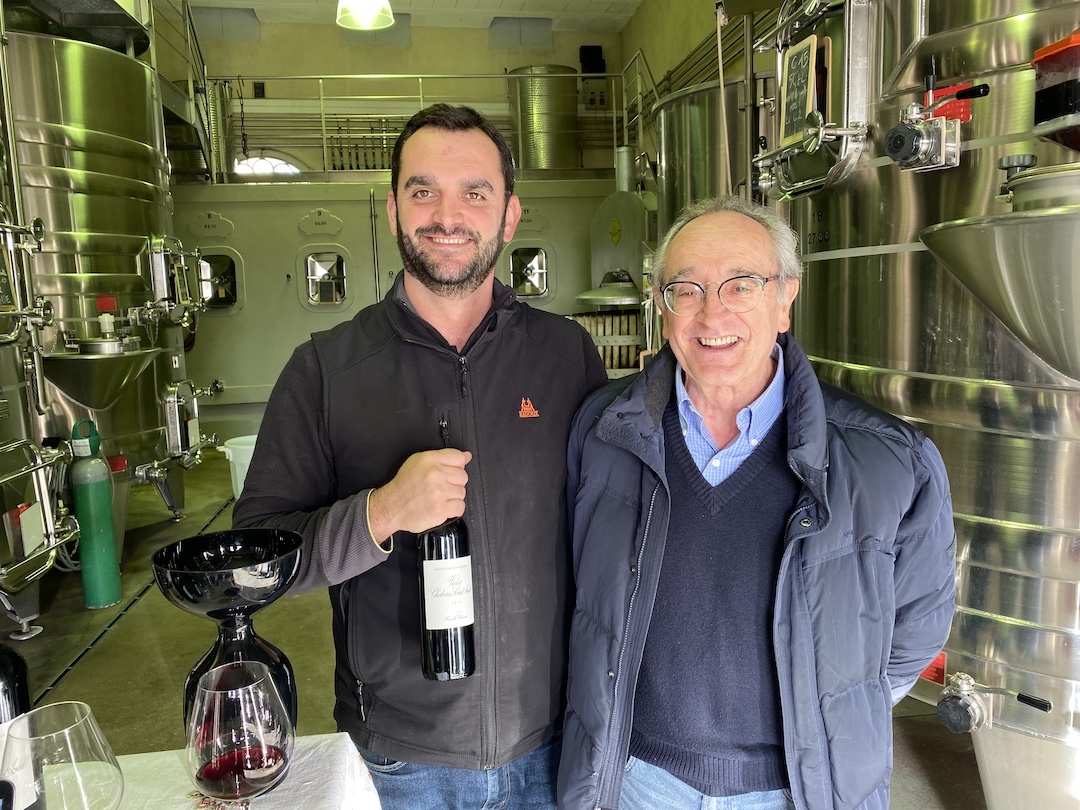
Jeff and Jean-Claude Berrouet at Vieux Château Saint André
The Vieux Château Saint André 2018 was bottled came across a bit reduced, but aeration reveals a wine of fine structure and much vibrant red fruit, with crushed mint and pepper aspects. Even better to me, at the time, was the Vieux Château Saint André 2019, which displays more evident blue fruit and much density, with the limestone lending freshness and ripe fruit. This has character and freshness. Jean-Claude explained that at the time of the tasting the 2018 was in a bit of a closed stage.
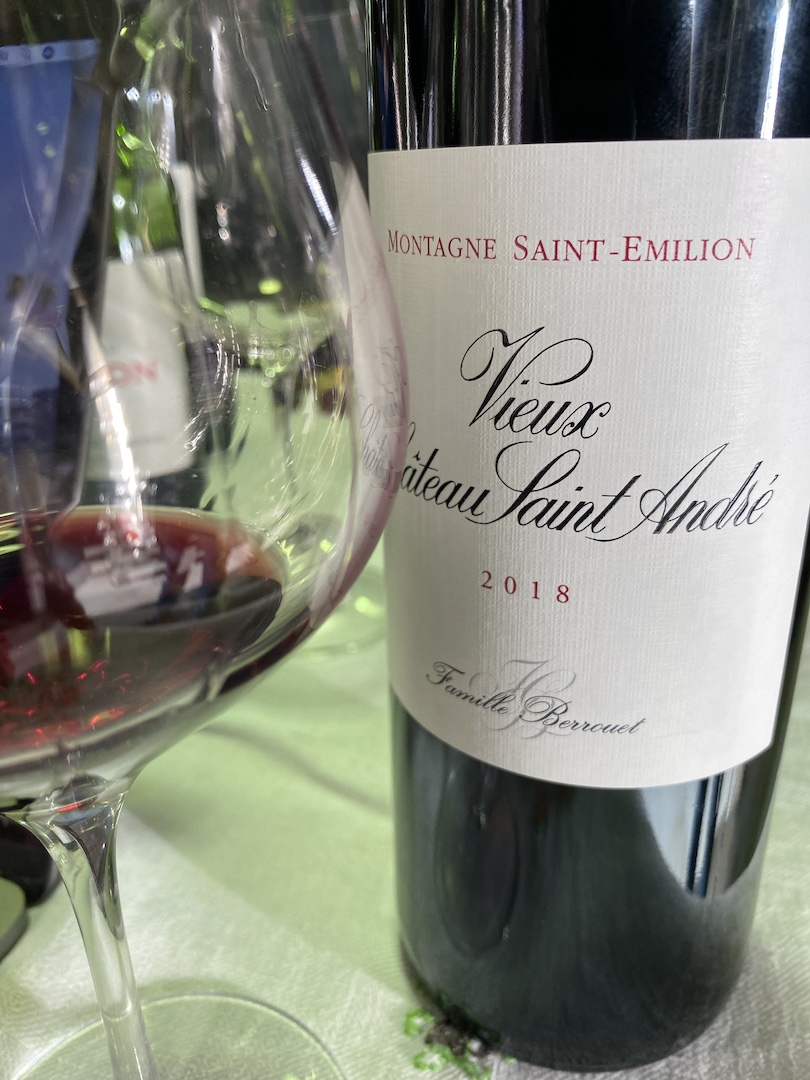
Consistently excellent
Both the Château Samion and especially the Château Bonneau 2019s were excellent, the latter property benefitting from much limestone soil so you get lots of freshness and cool fruit, having aged in 10% new oak.
Fronsac
Many thanks to Château la Rivière 2018 for delivering to me their white and red wines, both excellent, although I prefer the 2019 vintage at this estate, at least compared from barrel. The red 2018 is succulent and plum driven, with a certain wet stone aspect and fine grip. 92
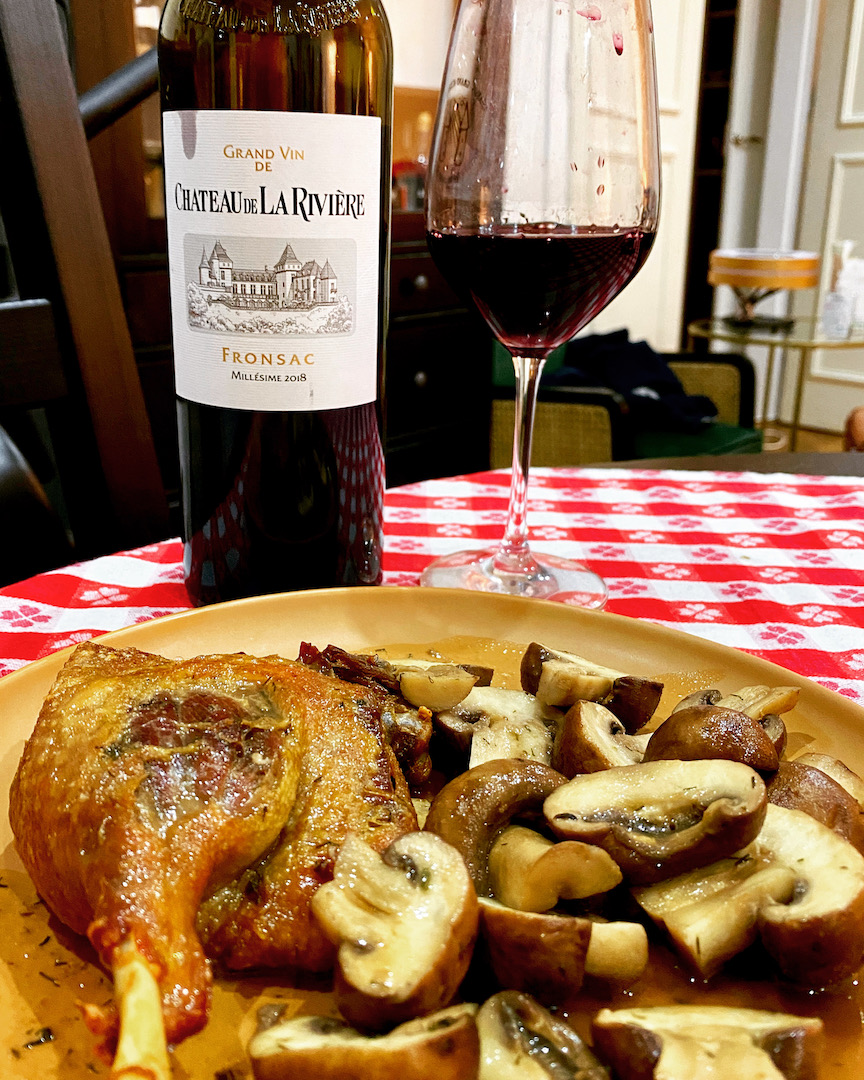
A nice pairing with roast duck and mushrooms!
I also appreciated a tasty and affordable Lalande de Pomerol, the Enclos de Viaud Lalande de Pomerol with a very welcoming nose and fresh palate with depth. The argile (clay) in the vineyard helped through the dry heat. There also is a gravel hill over the clay. The palate is frank and friand. €14 retail. 90
Castillon Côtes de Bordeaux: Blind tasting
Just as I have experienced in recent years with Fronsac, you can find relatively low-priced gems from this unsung appellation.
With a variety of soils and exposures, the Castillon Côtes de Bordeaux was well known for its Middle-Ages port that delivered wine to royalty, and to the English. Intervening years proved less glamorous. By the modern 1934 classification, the wines were sold under the diminutive “Près [near] Saint-Emilionnais.” Since the 2008 vintage, the four appellations of Côtes of Blaye, Cadillac, Francs and Castillon entered into a union known simply as Côtes de Bordeaux.
Although long overshadowed by Saint-Émilion, talented producers have been crafting fine wine in the modern era. Brands like Domaine de l’A or the Château d’Aiguilhe from Stephan Von Neipperg have a large following in the United States.
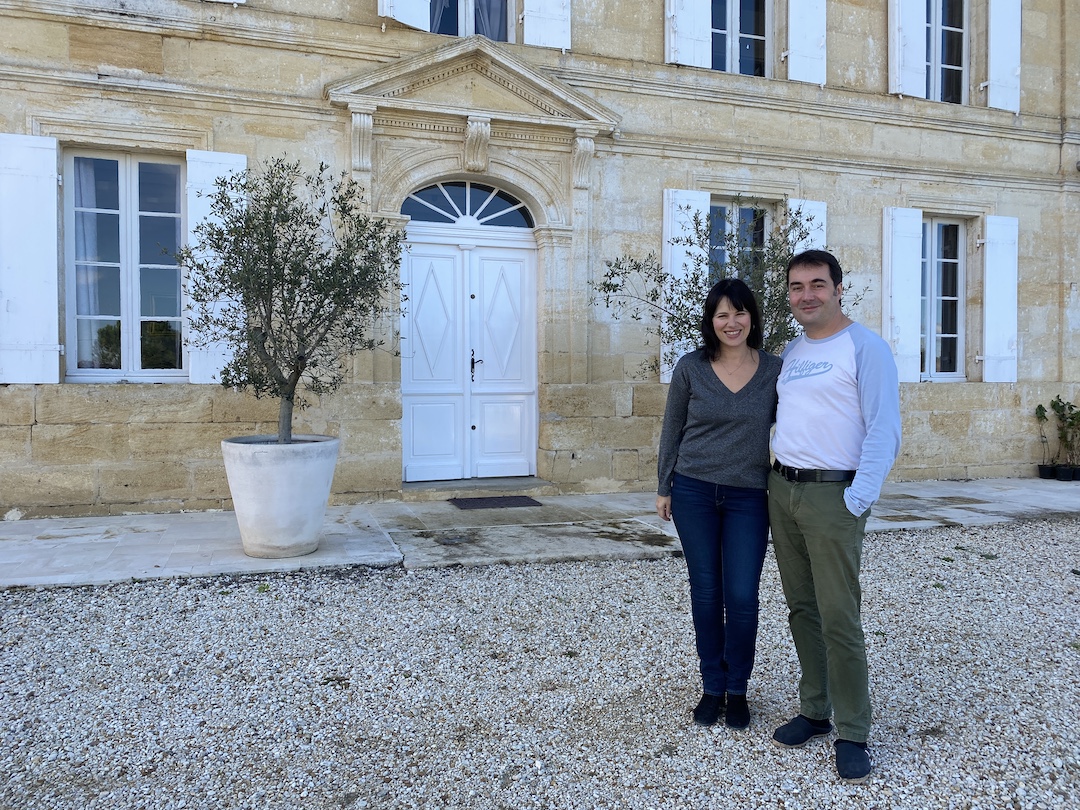
Jean-Christophe Meyrou and wife Anne-Sophie at Château Le Rey
Welcome Freshness
Like other Right Bank regions, this appellation had fallen victim to excessive oak extraction fashion going back to the mid 2000s, but Castillon Côtes de Bordeaux more recently mirrors a change in style towards freshness. I was happy to experience this change in the 2018 vintage vertical, organized by Jean-Christophe Meyrou of Vignobles K, which includes two wines from the appellation, as well as the Saint Emilion estate Château Bellefont Belcier, where I tasted the 50 wines blind.
While a few wines were not up to par, either coming off as rustic or even giving off iffy aromas (perhaps derived from less-than-clean oak), most ranged from tasty to excellent. All bottles cost at least €10 per bottle retail, to weed out cheaper supermarket brands often made from vines grown close to the river on lesser, sandy soils. Some well-known brands cost well over €10 retail, but many that cost less proved just as good, if not better, than quality Saint-Émilion.
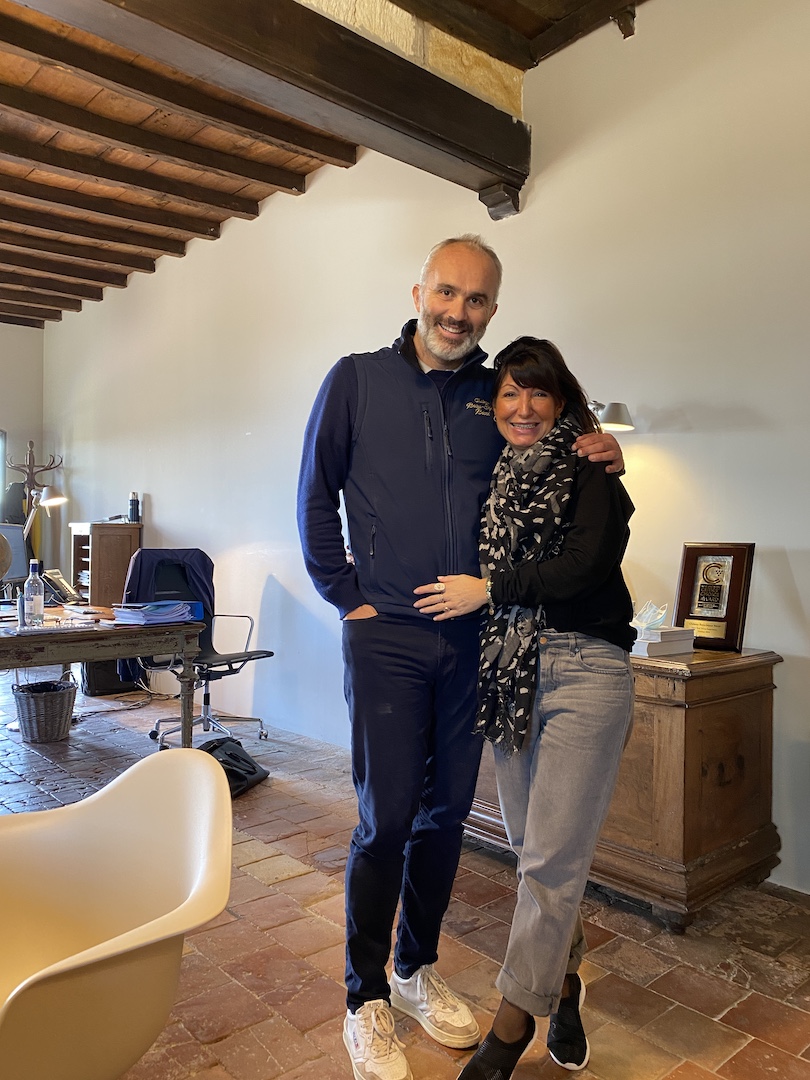
Tasted non blind, an excellent Château Joanin Bécot with co-owners Juliette Bécot and Julien Barthe
Indeed, one excellent example is the recent transformation of Château Joanin Bécot (92 points), which in 2018 is lovely and fresh, with less new oak. “In the past we went up to 70% new oak, but now we stay with 50%, explains co-owner Juliette Bécot, when I tasted the wine at Château Beau-Séjour Bécot in Saint Emilion.
Climate Change: What, Me Worry?
Based on the Dordogne riverside town of Castillon-la-Bataille, scene of the last battle of the 100 Years War in 1453, the appellation counts well over 2,800 hectares of vines. Some 230 families work in properties that average about 10 hectares each. With an altitude difference of over 100 meters, three major types of terroir make Castillon complex: Gravelly near the Dordogne river, clay soils at the foot hills that turn to clay limestone and then the excellent limestone plateau. As vintages get warmer, the cooler climate of this appellation east of Saint-Émilion has proven a foil to climate change.
After the blind tasting, I came away impressed. Of course, as with all such tastings – from 10 am to 12:30 pm – I may have been too quick to judge, as the ideal would have been to spend more time with each bottle, but that is how such tastings work. 😊
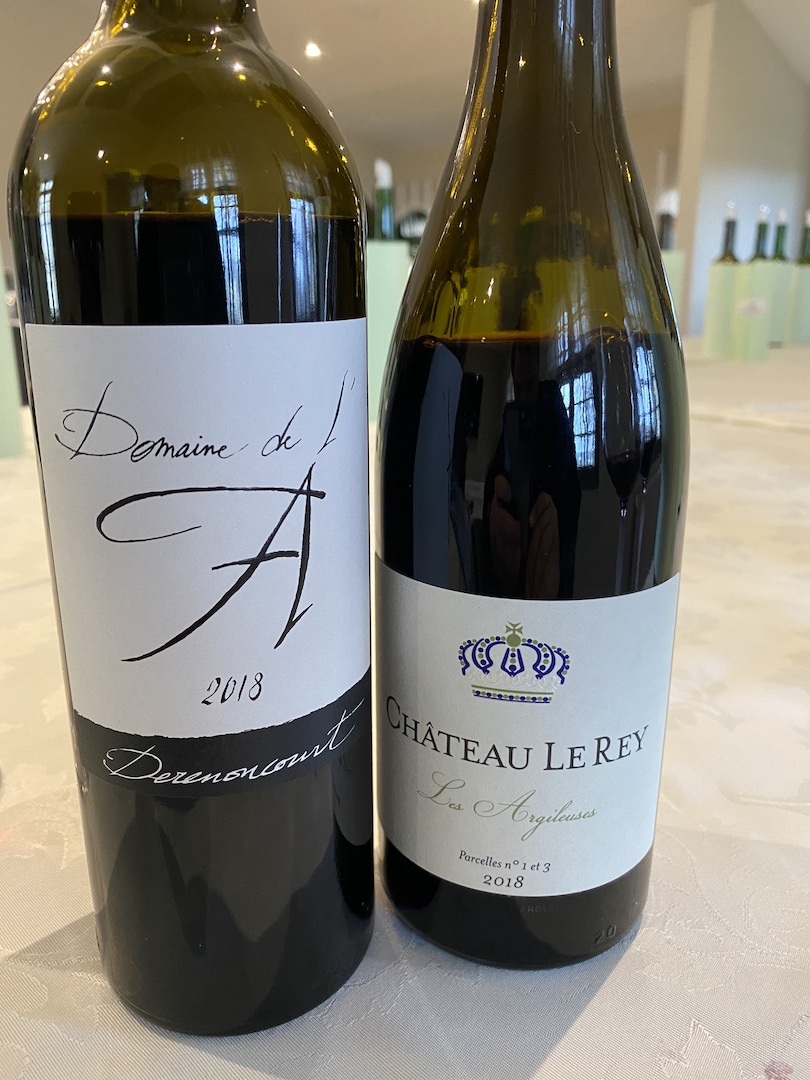
Two fine wines from Castillon Côtes de Bordeaux
Blind tasting
As usual, when in bold, I liked in particular. If red and bold, even more. These are the immediate “raw” notes taken.
- Lovely nose, ripe fruit, the palate is engaging; there is a tannic edge to the wine, but in a positive, structural manner. Does not dry on the finish. 14.5% alcohol. Clean and fine, if not especially amazing either. 88 (Château Blanzac by Romain Depons)
- Chocolate, sweeter nose. There is verve to the wine. 14%. The most density so far, although I prefer wine #1. This one costs €29 retail. I wouldn’t pay that much. 88 (Le Pin de Belcier by Frédéric Dubois)
- This has an element of tannic edginess too, with fine body. You so far do not have the depth or grace of a top Saint Emilion. But at €20, a better deal. 89 (Château La Croix Lartigue by Maison Kavaklidere)
- Like 3, a sweeter profile. Some jam aspects and then somewhat harder tannin. But a pleasing sensation… gouleyant. I only found out after unveiling that this is crafted under Michel Rolland. 14.5 alcohol. I can see how it is popular. Retails for about $15. 90 (Château de Laussac by Vignobles Robin)
- Although the preceding wine seems a bit more friendly, this one comes across especially refined, and it has power. The 14.5% alcohol is well integrated in this blend of 90% Merlot and 10% Cabernet Franc, with freshness and precision. I like the structure and concentration as well, no doubt due to the high average age of the vines – at over 80 years! Not sure if available in the United States, but it costs about $30 retail in Europe. Importers take notice! (Château Peyrou by Catherine Papon-Nouvel). 92+
- A bit more vegetal in aspect, but with a juicy mid palate. However, one senses a bit of under ripeness. 87 (Château Grimon by Gilbert Dubois)
- A bit more coca cola, kind of simple for me. 86 (Château Lescaneaut by Vignobles Boueix-Faytou)
- Tasty, juicy. 14.5% alcohol. For 13€, you get a friendly juice albeit not very profound either. But no wrinkles. 87+ (Château de Belcier by Frédéric Dubois) 80-20 CF.
- Coco powder, smooth tannin, this stands out, also for the fruit. And yet, coming back, after tasting some of the others, this is just OK. Kind of short? 87 13.5% alcohol. (Château La Gramonide Clos Gramond, by Vignobles Galineau)
- Nose is somewhat closed in. But I like the juiciness and depth on the palate, quite impressive! Indeed, this one seems very good. 90. Old vines, 40 years old. 14.5% alcohol (Château Beynat Cuvée Léonard by Alain Tourenne)
- This is somewhat off on the nose. A bit metallic on the palate, although you get a sense of ripeness, the tannin is a touch hard on the finish. (Château La Pierrière Cuvée du Fondateur 1607 by Famille de Marcillac)
- A certain purity of fruit on the nose here, you get a sense of limestone. Delicate and not so much power. Easy going but more to it that just that. 88 (Château des Demoiselles by Vignobles Ducourt)
- Rich nose. Darker color than preceding wine. Freshness and substance, some mint leaf too. Lovely and actually quite delicious. 14.5% alcohol. 90 (Château Bréhat by Béatrice de Monteil) The blend is 70% Merlot, 15% each of Cabernet Franc and Sauvignon, aged in 50% new oak. Just over five hectares of vines at the foot of the slope, with with south/southeastern exposure and with some limestone, sand and clays.
- A bit hard. Not drying, not off putting, just standoffish. It lacks charm but let us revisit in 5 years? Just under €14. 33% new oak. This producer does not like to put the alcohol levels on his labels. (Château Claud-Bellevue by Maison Kavaklidere) 87
- After unveiling, I recognized the label from the Grand Cercle tastings over many tastings. Clocking in at 14.5% alcohol, the blend of 80% Merlot and 20% Cabernet Franc comes from vines on clay limestone soils, averaging 35 years of age. There is both power and finesse to the wine, with a certain youthful tannic aspect neither hard no drying, but requiring two or three years cellaring for optimal pleasure, although you can enjoy it today with thick steak on the grill. Aged in 50% new oak, but what if they would have toned that down to 40% ? I wonder whether it could be even better. But at under $20 retail, a bargain! (Château Côte Montpezat Cuvée Compostelle). 92
- Notions of mint, but a bit rustic And yet the palate has body and contour. Indeed, that is what impressed me most. The body and contour. 87+ (Château Beynat Cuvée des Lyres by Alain Tourenne)
- Spice, cumin, cardamom, tasty, juicy, maybe lacks the verve and freshness an more interesting opulence to be really good. (Château de Chainchon, Le Soutien-Gorge Rouge) 87+
- Love the cooler, blue fruit tones of Château Anvichar by Vincent Galineau, as the wine reflects poise and refinement for the appellation, even if may seem now seem a tad standoffish, but there is no hard tannin or drying. You get density and bite, so give it another three to five years in your cellar to resolve itself, and it will be fine. 14% alcohol and made from vines averaging 35 years old. 90
- The palate has freshness and there is a gouleyant aspect, a hint of jam, maybe, but overall really pleasant drinkability. 5 (Seigneurs d’Aiguihle) 90+
- Hint of volatile. This is actually rather hard on the palate. Note reserved. (L’Ame de Fontbaude by Vignobles Sabaté)
- This is rather straightforward and tasty, if perhaps a tad foursquare. 88 Les Truffards du Domaine d’Argilius by Vignobles Battistin)
- TCA? (Château Canon Montsegur Lancelot by Sébastien Pelard
- This is again rather straightforward and solid. A bit more hard tannin, but also fine density. 88 (Clos Védélago by Jean-Paul Védélago)
- A bit standoffish, bordering on metallic, but there is ripe fruit and a warmth without being hot. Maybe needs more time. 88 (Château Les Armes de Brandeau Cuvée Privilège by Nathalie Lauret)
- Some mine de crayon here, fascinating nose. Somewhat hard and lacking in charm on the palate (give it a few years?), but I like the mid palate density. 14% alcohol (Château de Demoiselles Réserve de la Famille) 89
- Freshness and poise here, with vivacity and a lift on the finish that beckons further drinking. Ripe fruit bien sûr! 60% M and 40CF clay limestone, southern exposure, and hillside slopes with southern exposure. (Château de Laussac Cuvée Sacha) at 14.5% alcohol. You really want to drink this one. And bravo to Michel Rolland. Yes, it is 100% new oak, and even the malo is done in new oak. Despite all that, I did not get an overtly modern gloss. Indeed, I know this label as well from the Grand Cercle, and I think I liked it less in earlier vintages. 60% Merlot, 40% Cabernet Franc, on clay and limestone, with an average vine age of 45 years, which can explain the superior grip to the regular cuvée. All in 100% new oak, but somehow manages balance. Retails for about $23. 93
- This has some straightforward aspects, not bad. Smooth enough but lacks enough nuance for a higher score 88 (Château Rochers de Joanin by Famille Despagne).
- Also rather fine, density and length. Solid. (Valmy Dubourdieu Lange Chateau de Chainchon by Famille Erésué)) 20% new oak, 100% Merlot and 12 months in barrel. 15% alcohol, and yes, it came off a bit heady whilst tasting. I reached for some water, but I can see how that may please some palates. 87+
- This is solid, too, but not as top heavy. Quite nice, better than the preceding wine. 88 (Château La Brande by Famille Todeschini)14% alcohol.
- This has punch to it, lacks elegance or nuance however. 87 (Château Manoir du Gravoux Le Secret du Manoir by Séverine and Philippe Emile)
- I like the juiciness to this wine, more interesting than the preceding entry. 89 And yet 15% alcohol. Well managed. (Château Clarisse by Le Calvez Mathé)
- There is a freshness that must be the limestone! I like it very much. It does seem a bit austere on the finish however, but when I went back to it, I realize that that is good for aging, as the wine does not dry up or get hard. 93 (Château Ampélia by Famille Despagne) 80% Merlot, 20% Cabernet Franc, indeed with vines on the plateau of Saint Philippe d’Aiguilhe, so clay limestone over limestone. Lovely juice.
- This is also very solid! With freshness. OK, a touch monolithic however. 88 (Château Roquevieille Cuvée Excellence by Vignobles Palatin Guibert)
- Quite good, and for some reason I caught myself thinking of the solid series of emperors in the second era of the Roman Empire like Aurélian who came from present day Croatia: not as good as the Golden Age, where we can put the best of Saint Emilion, for example, but darn good. Anyway, more a blockbuster wine, a certain thickness to it, or even just a bit monolithic, but I can see how it pleases. 90 (Château d’Aiguihle) It pleased me de premier abord. Go back to the spicy regality of Cote Montpezat (18) however, and there you get a really yummy wine! Funny how I prefer the second wine from Neipperg when tasted blind.
- Classy enough, a bit of tannic edge but in a good way, well managed extractions – this last series of wines quite successful. 92 (Domaine de l’A by Christine and Stéphane Derenoncourt). Retailing for about $50, this rather expensive (and rather well known for the appellation) wine by Christine and Stéphane Derenoncourt is indeed classy, albeit with tannic edge (in a good way), and with well-managed extractions. The blend of 75% Merlot and 25% Cabernet Franc was aged in 40% new oak. Give it time and the score will go up..
- And yet, even better, when tasted blind, is the less expensive Château Le Rey Les Argileuses by Vignobles K, with pleasing tartness that makes you come back for more. I like the freshness here more – aged in amphorae and stainless steel – and it proved to be one of my favorites of the tasting, even if it the preceding wine (due to greater density) may outlast it. Retails for about $15 93 (I can confirm this as being so yummy as in an earlier, non blind tasting, I had a similar experience of “very fresh and rich and silky”. The wine is made with minimal sulfites, just at moment of bottling. “We have many Michelin restaurants that serve it by the glass”, said director Jean-Christophe Meyrou. The blend is 85% Merlot and 15% Cabernet Franc.
- This is also fresh and refined. I rather like this as well for its drinkability. Not quite as focused however. 90 (Page Noir AOD Wine)
- A bit church banister on the nose but the palate has density. Still, what is the oak quotient here and that is why it comes across a bit odd, out of whack? Not sure! (L’Aurage by Caroline and Louis Mitjavile) Interesting to see the 15.5% alcohol after uncovering it.
- Freshness and fun. A fine bitterness to the finish. Indian Tonic. May not be to all tastes, however. (Château de Chainchon, Teha by Vignobles Erésué). 89+
- Frank and tasty, but not as good as the #43. 89 (Château Le Rey – Les Rocheuses by Vignobles K). Special note: when tasted non blind at the property, with director, I preferred the Rocheuses!
- This is better, more verve, more interest. Amazing how the wines tend to start to resemble one another in this series at least. 90 (Page AOD Wine)
- Not quite as exciting to me. A bit more ho-hum, although with a solid notion of freshness and ripeness. 87+ (Château Les Armes de Brandeau Cuvée Trilogie by Nathalie Lauret) 13.5% alcohol.
- This has greater depth and is actually quite enveloping while retaining freshness. And yet, still a bit hard. 88 (Arion by Château Moulin de Clotte by Maison Celene).
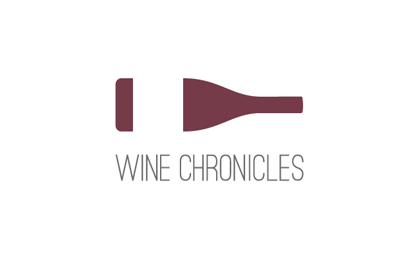 Wine Chronicles
Wine Chronicles
Share This